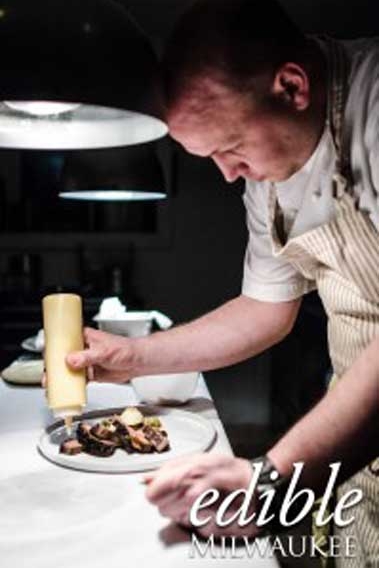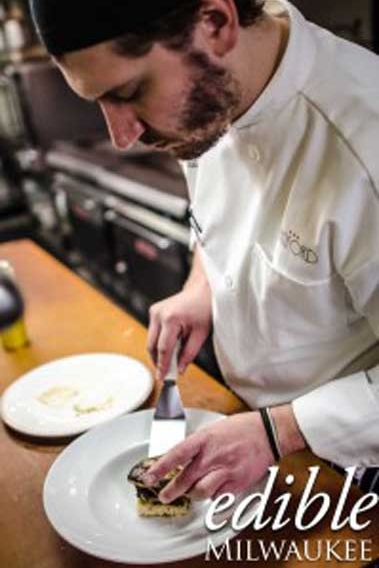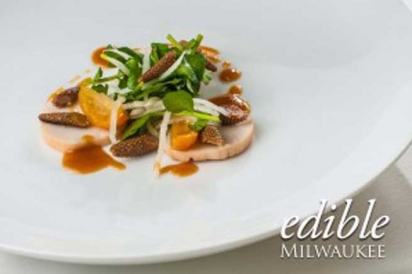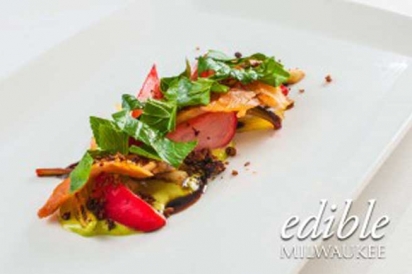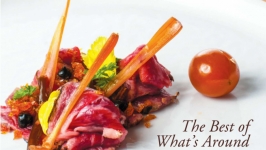The Best of What's Around
Invasive species and other uncommon ingredients make for diverse eating
The idiom “what’s old is new again” has an inscrutable origin, but is purported to have made appearances in everything from the Bible to The Lord of the Rings saga. Nowhere does it ring more true, though, than in cooking.
As ingredients and cooking techniques change with the seasons, so do they ebb and flow in how and why they’re used. But some ingredients that are familiar to many may not always have been; likewise, some ingredients that are all around us, even to the point of being a nuisance, are only now starting to get their due.
From weeds to invasive species, local chefs are embracing an increasing number of nontraditional ingredients and doing their part to educate diners on how, and why, it’s important to eat the stuff our great-grandmothers might have cooked with.
Availability the Mother of Invention
At Ardent on Milwaukee’s East Side, the small dining room a few steps below street level belies the outsized innovation taking place in its kitchen. The creativity of chef/owner Justin Carlisle and chefs Aaron Patin and Matt Haase led to Ardent being named a semifinalist for the 2014 James Beard Award for Best New Restaurant in the U.S. This year, Carlisle is a finalist for Best Chef Midwest.
Undaunted by the unfamiliar, they’ve found success using humble plants—weeds, bulbs, pods, twigs, roots and other erstwhile castoffs, some of them invasive—to accentuate and elevate extraordinary dishes.
“Honeysuckle, knotweed, kuzu starch, cress, garlic mustard, most of these are garnishes or components that add layers of flavor,” said Patin. “They’re never the center of a dish, but what we do here isn’t necessarily protein/starch/vegetable. A lot of it is doing research on vegetables or plants we can forage here in Wisconsin. We forage it and taste it. If it’s delicious, we use it.”
Carlisle said Ardent’s chefs extend the life of what they use whenever possible, applying different methods to small quantities of multiple ingredients in order to see what turns out the best.
“These things only have so much shelf life, so we need to use them however we can,” he said. “Can we pickle it, preserve it, salt cure it, dry it? We even dehydrate most of our scraps to make bouillon or seasoning powder. We know how to preserve the bulk of what we get so it doesn’t go to waste. This allows us to use seasonal ingredients year-round.”
The tasting menu at Ardent changes daily, with some dishes staying in rotation for longer than others. Carlisle estimates six to eight dishes change daily, so the staff’s penchant for experimentation comes in handy.
“We have a CSA farmer we use who forages for us and brings things in,” said Patin. “50% of it, we don’t really know what to expect. She’ll show up with things like a bushel of sumac berries, and we think, ‘what are we gonna do with those?’ We have to work through the what, how, why, and incorporate these ingredients most of us never really worked a whole lot with.”
Perhaps more important than research and experimentation, he adds, is a meaningful connection to an ingredient’s origin, whether it’s considered invasive or just misunderstood.
“You can buy any ingredient you want from anywhere in the world, or you can go into your backyard and get some for free,” he said. “It’s about being conscious of how you source your products. There are companies we can buy edible flowers from, or there are pots we can just grow them in.”
Patin said this philosophy isn’t necessarily inherent to Ardent, but rather an indication of how its chefs think.
“It’s just like salt and pepper. If you can add a floral note or a spicy note from a flower or an herb, and it’s invasive and people are willing to give you bags full of it, why not use it?”
More Than Meets the Eye
This commitment to incorporating invasive or nuisance plants and other castoffs isn’t unique to Ardent. Other restaurants in the city are making similar efforts to embrace these ingredients.
Peter Gebauer, executive chef at Potawatomi Hotel & Casino, said that when the property’s operations expanded in 2008, part of the business plan was to be more environmentally conscious and drive sustainability. This reflected the strongly held beliefs of tribal leaders, and led to research and education for the food and beverage team.
“I learned about Asian carp and the fear of it coming into the Great Lakes,” he said. “One day I just thought, let’s get some in, play around with it and see what happens. Whether it’s seafood or produce or fruit, we try to find something that’s fallen by the wayside or that no one pays attention to.”
These wayward ingredients are numerous—broiled or smoked eel, done in different Asian or Western applications; shad roe; pawpaw, a mango-like fruit common in Ohio and Michigan, used in coulis and ice creams; shagbark syrup, made from the bark of a hickory tree, featured on the menu at Locavore as an accompaniment to pancakes and waffles.
But it’s Asian carp, the invasive species perhaps most familiar to Milwaukeeans, that has gotten the most traction at Potawatomi. It’s appeared as a special on weekends as well as for catering events, and has found a home on the menu at RuYi where it appears as smoked fish cake sliders with tomato, jalapeno and spicy cream. Head Chef Tony Ho has also served it steamed with a spicy black bean sauce, thinly sliced in a hot pot, in fish head soup, or braised in a Singapore-style curry.
“The meat is very sweet and the texture is excellent,” Gebauer said. “Some people tell us, ‘hey, this is better than a crab cake!’ The reception has always been very positive.”
Potawatomi gets silver, grass or bighead carp at 8-10 pounds each through Empire Fish in Milwaukee, which procures them from a fishery on the Mississippi River in Illinois. It isn’t the only invasive fish Potawatomi is experimenting with.
The casino got its first snakehead about a year and a half ago and its chefs continue to use the fish whenever they can get it from Virginia. Snakehead flesh, like that of sea bass or walleye, is meaty, yet delicate and delicious. It’s been served pan-seared with drawn butter as a catch of the day, as well as fried.
The elusive predator is at the top of the food chain, can survive out of water for 4-5 days, and can move on land. Gebauer said using it is worth the wait; where carp net a 20-25% yield because of their significant bone structure, snakehead provides about 60%.
While these fish are invasive in some parts of the country, and carp are knocking on the door of the Great Lakes, there is still hesitancy to belly up to the table and help eat them out of existence. Unlike the ‘rebranding’ that turned Patagonian toothfish into Chilean sea bass and slimehead into orange roughy, efforts to shill carp as “silverfin” or “Kentucky whitefish” haven’t gotten much traction. For some, there’s no need to impress.
“I grew up on a lake in Illinois and everyone fished for carp,” said Ardent’s Patin. “The lake was stocked with bass and pike, but if you wanted to catch a fish for dinner that night, you’d catch a carp. Friends from school would give me weird looks, but if you cooked it right, it was delicious.”
When considering the notion that increased demand for an invasive species may run counter to the goal of eradicating it, Patin offered a simple solution.
“I think there needs to be more of an attitude of ‘how do we use this?’ rather than ‘how do we destroy this?’”
Carlisle agreed, drawing a parallel between the lack of awareness about invasive species as food sources and the tendency of some to follow ingredient trends at the expense of historically important and often readily available ones.
“There are things that have been here forever that people no longer use, things that are part of our heritage and have grown in this state or this area forever,” he said. “Why aren’t people using more milkweed? Why aren’t they using radish pods instead of waiting for the radishes? Japanese knotweed is in the rhubarb family, so why do we wait for rhubarb when we have knotweed all summer long that can be cooked the same, canned the same, braised the same, and take on the same flavors because it’s the same cell structure? People just think of it as a nasty weed.”
He offered an example of how a humble, quick-growing and widely available plant not often thought of as food—cattails—surprised diners at Ardent.
“We made them the central focus of the dish,” he said. “Braised them in shallot and garlic stock for a day, picked off the weeds, pickled the tops, turned the peelings into consommé with green garlic confit, and steeped the tops in cream overnight to make an eggless custard with seaweed. Most people thought we were crazy, but when they ate it…”
The Ethnic Roots of Leaves and Shoots
A number of invasive and nuisance plants also make appearances on the menu at Sanford, the venerable lower east side restaurant long cited as one of the best in Wisconsin. Chef/owner Justin Aprahamian, 2014 James Beard Award winner for Best Chef Midwest, said that his approach to using these ingredients is rooted in ethnic cooking.
“What might be seen as a weed by some is very valuable to others,” he said. “I’m Armenian, and in Armenian cooking, sorrel is prevalent. It grows wild in the mountains. When it starts, it takes over in a pretty big way. We use a lot of that in soups and salads. Purslane is also a lot like a weed, but it has a tart, lemony bitter taste. But that comes back to ethnic cooking; in the Middle East, it grows in the mountains and is used frequently.”
Aprahamian rattles off a list of ingredients that would make a botanist blush, each of them a carefully considered component of Sanford’s elegant but approachable cuisine.
“Fiddlehead ferns, mushrooms, ramps, nasturtium greens, burdock root, violet leaf, dandelion greens, trout lily… these are all things I’m a big fan of. We use the trout lily in salads and we make a pesto with it that’s pretty tasty. We do a soup with the nasturtium greens that’s really fresh and vibrant.”
Aprahamian said Sanford’s cooking draws inspiration from different places, and a single element can serve as a lynchpin.
“Some dishes start with an ingredient, or we have an idea for a dish and think, ‘wow, that fills a void perfectly.’ Cattails are an example of that. We were playing around with doing sake-cured scallops and thought to pickle the cattails, add watercress, some winter radish and a warm miso dressing. The cattails were an awesome compliment and fit perfectly with the flavor profile we had in our heads.”
He cites purslane as another prime example: “We really wanted to build a dish with that at the forefront. So we made a purslane broth with a corn risotto and used pickled purslane to garnish a piece of fish that was on top. We’ve also pureed it in soups, pickled it, and used it fresh in salads.”
Like Carlisle and Patin, Aprahamian underscored the value of research when working with new products—what family something comes from, whether it needs to be cooked if it’s been foraged, and more. Fiddlehead ferns, for instance, need to be cooked before they’re eaten because they’re mildly toxic when raw.
While many ingredients of this nature can be acquired through a purveyor, others are foraged or acquired from ethnic markets, where there’s often a natural audience for items not typically found at the average farmer’s market.
“It’s really educational to seek new things out, talk with people about them, and push yourself to figure out how to use them,” Aprahamian said. “We’re fortunate in that we have people coming here knowing they’re not going to get something typical. Sandy [Sanford D’Amato, the restaurant’s previous owner/chef and perhaps Milwaukee’s most lauded chef] set a very high standard of creativity over the years, so there’s a certain level of expectation. People aren’t totally shocked by some of these ingredients, but they’re still curious. We do have some say ‘I didn’t know you could eat that!’”
As for the notion that a new or less familiar ingredient gaining popularity may unintentionally cause more established ones to become underutilized and therefore perpetuate a cycle, Aprahamian agrees.
“I think that’s a brilliant take on it. One of the things Sandy always said was that everything in food cycles in a big way. Pomegranate was really big years ago and then it kind of fell off; fig, the same thing. Everyone was using them until it fell out of vogue and now it’s back. You see that pattern a lot.”
One plant surging in popularity and already suffering from it is the ramp, or wild leek. A threatened species in Quebec, ramps are a species of ‘special concern’ in several U.S. states where feasts and festivals encourage unsustainable harvesting. Aprahamian recalled reading an article about ramps that sounded an alarm.
“There are people fearful that, because of their popularity and trendiness, we’re going to pick them out of existence. If you keep picking them, you’re thinning them out, and people don’t really know how to pick them to ensure they keep coming back. I think we’ve created enough demand for some things that they aren’t what they used to be.”
For some species, though, he admitted it would be “fantastic” to get to the point where there’s sufficient demand.
“It would be very telling if we could fish an invasive species to extinction, as opposed to all the other great fish out there that we’ve pushed to the brink. It would be refreshing to see it come to that.”
This sentiment was echoed by several chefs, whose goal is often to create a delicious and memorable experience for their patrons, but whose responsibility may be to continue pushing boundaries and utilizing the bounty in their proximity.
“As certain things become popular, people get away from some of the recipes that are so important or that got us where we are,” said Patin, “so it’s nice to see that if you put the emphasis back on indigenous ingredients, you can utilize what’s already here for the taking.”



